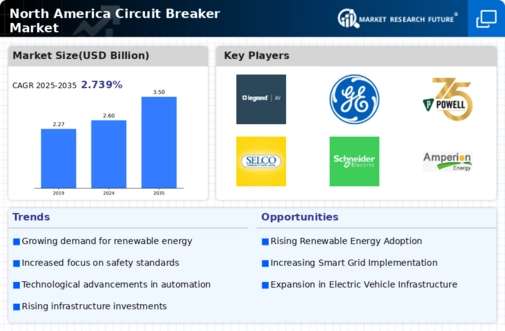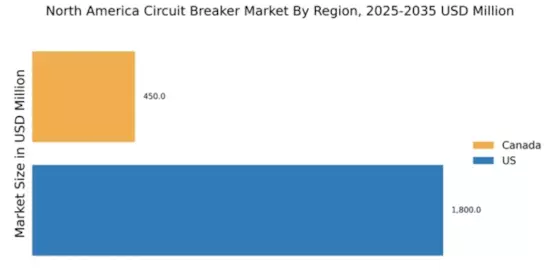Rising Demand for Energy Efficiency
The circuit breaker market in North America experiences a notable surge in demand for energy-efficient solutions. As consumers and businesses alike strive to reduce energy consumption, the adoption of advanced circuit breakers that minimize energy loss becomes increasingly prevalent. This trend is further supported by government initiatives aimed at promoting energy efficiency, which may lead to a projected market growth of approximately 8% annually through 2025. The circuit breaker market is thus positioned to benefit from this heightened focus on sustainability, as manufacturers innovate to meet the evolving needs of energy-conscious consumers.
Growth of Electric Vehicle Infrastructure
The expansion of electric vehicle (EV) infrastructure in North America is poised to significantly impact the circuit breaker market. As more charging stations are installed, the demand for robust electrical systems, including circuit breakers, is likely to rise. This trend aligns with the broader shift towards sustainable transportation solutions, which may lead to an estimated market growth of 9% in the coming years. The circuit breaker market must adapt to the unique requirements of EV charging systems, ensuring that products are capable of handling increased loads and providing reliable protection.
Increased Focus on Safety and Reliability
Safety concerns remain paramount in the circuit breaker market, particularly in North America. The rising incidence of electrical fires and equipment failures has prompted both consumers and businesses to prioritize reliable circuit protection solutions. Regulatory bodies are also tightening safety standards, which may compel manufacturers to innovate and enhance their product offerings. This heightened focus on safety is expected to drive market growth, with estimates suggesting a potential increase of 7% in demand for advanced circuit breakers designed to mitigate risks and ensure compliance with evolving safety regulations.
Infrastructure Upgrades and Modernization
In North America, aging electrical infrastructure necessitates significant upgrades, driving growth in the circuit breaker market. Many facilities, particularly in urban areas, are investing in modern electrical systems to enhance reliability and safety. The circuit breaker market is likely to see increased demand as utilities and commercial entities replace outdated equipment with state-of-the-art circuit breakers. This modernization trend is projected to contribute to a market expansion of around 6% annually, as stakeholders prioritize the integration of advanced technologies to ensure operational efficiency and compliance with contemporary safety standards.
Technological Advancements in Circuit Protection
Technological innovation plays a crucial role in shaping the circuit breaker market in North America. The introduction of smart circuit breakers, which offer enhanced monitoring and control capabilities, is transforming the landscape. These advanced devices not only improve operational efficiency but also provide real-time data analytics, enabling users to optimize energy usage. As the market embraces these technological advancements, growth is anticipated at a rate of approximately 10% annually. The circuit breaker market is thus likely to witness a shift towards more intelligent solutions that cater to the demands of modern electrical systems.


















Leave a Comment